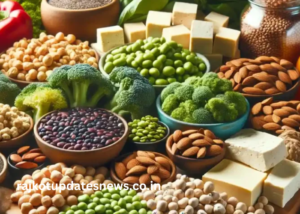
In today’s health-conscious society, the focus is often on what to include in our diets, but a wealth of nutritional benefits lies hidden in the peels of fruits and vegetables. The phrase “eat your peels” may sound simple, but it encapsulates a growing movement toward utilizing every part of our food.
The wellhealthorganic.com: eat your peels: unlocking the nutritional benefits initiative emphasizes the importance of incorporating these often-discarded parts into our daily meals.
Peels are not only edible; they are often more nutrient-dense than the flesh itself. Rich in fiber, vitamins, and antioxidants, fruit and vegetable peels can contribute significantly to our overall health. This guide aims to explore the various benefits of eating peels, provide practical tips for incorporating them into your diet, and answer common questions regarding this nutritional powerhouse.
Key Points
- Many fruit and vegetable peels contain higher concentrations of vitamins and minerals than their flesh.
- Incorporating peels into your diet can increase fiber intake and promote digestive health.
- Understanding how to prepare and consume peels safely is essential for maximizing their benefits.
What Nutrients Are Found in Peels?
Peels are often rich in various nutrients, making them valuable additions to our diets. Here’s a detailed look at what nutrients you can find in some common fruit and vegetable peels:
- Fiber: Peels are high in dietary fiber, which aids digestion and helps regulate blood sugar levels.
- Vitamins: Many peels contain significant amounts of vitamins A, C, and K. For example, apple peels are particularly high in vitamin C.
- Antioxidants: Peels often contain antioxidants like quercetin, which combat oxidative stress and inflammation.
Here’s a comparison chart of various fruit and vegetable peels and their nutritional content:
| Fruit/Vegetable | Nutritional Benefits | Key Nutrients |
| Apples | High in fiber and vitamin C | Fiber, vitamin C |
| Potatoes | Rich in potassium and antioxidants | Potassium, vitamin B6 |
| Carrots | Packed with beta-carotene | Vitamin A, antioxidants |
| Cucumbers | Hydrating and low in calories | Vitamin K, silica |
| Bananas | Rich in potassium and magnesium | Potassium, vitamin B6 |
Note: Always wash produce thoroughly before consumption to remove pesticides.
Why Should You Eat Peels?
Eating peels can contribute to better health in several ways. Here are some compelling reasons to include them in your diet:
- Nutrient Density: Peels often contain higher concentrations of nutrients than the flesh. For instance, a study found that apple peels contain up to six times more antioxidants than the flesh.
- Weight Management: The fiber found in peels can promote a feeling of fullness, which may aid in weight management and reduce overall calorie intake.
- Cost-Effective: Utilizing peels reduces food waste, making your grocery budget stretch further while promoting sustainability.
Incorporating peels into your meals can significantly enhance their nutritional profile.
How Can You Safely Prepare Peels?
Preparing fruit and vegetable peels properly is crucial for ensuring safety and maximizing their benefits. Here are some tips:
- Thorough Washing: Always wash produce under running water to remove dirt and pesticides. A vegetable brush can help for tougher skins.
- Peeling Techniques: If you choose to peel, consider using a vegetable peeler that retains more of the peel’s nutrients.
- Cooking Methods: Some peels can be consumed raw, while others are better cooked. For instance, potato peels can be baked or sautéed for added flavor and nutrients.
Note: Avoid consuming peels from produce that has been treated with pesticides, unless they are organic.
What Are the Health Benefits of Specific Peels?
Let’s delve deeper into the health benefits of some common fruit and vegetable peels:
Apple Peels
Apple peels are a powerhouse of nutrients, containing high levels of vitamin C and fiber. They also provide quercetin, an antioxidant known for its anti-inflammatory properties. Incorporating apple peels into your diet can support heart health and improve digestion.
Potato Skins
The skin of potatoes is rich in potassium and B vitamins. Eating potato skins can help with muscle function and energy metabolism. Roasting or baking potatoes with the skin on can retain more nutrients and add a satisfying texture.
Carrot Peels
Carrot peels are packed with beta-carotene, which converts to vitamin A in the body. This nutrient is vital for eye health and immune function. Including carrot peels in soups or salads can enhance their nutritional value.
Cucumber Skins
Cucumber peels are hydrating and provide fiber and vitamin K. They are low in calories and can be easily added to salads or smoothies. The silica in cucumber peels supports skin health and elasticity.
How Can You Incorporate Peels into Your Diet?
Incorporating peels into your meals doesn’t have to be complicated. Here are some creative ways to include them:
- Smoothies: Blend banana peels or cucumber skins into your smoothies for added nutrients.
- Soups: Add potato and carrot peels to soups for extra flavor and nutrition.
- Salads: Toss in apple or carrot peels to salads for added texture and taste.
- Snacks: Bake or fry vegetable peels, such as potato skins, for a crunchy snack.
Note: Experiment with different preparations to discover what you enjoy most.
Are There Any Risks to Eating Peels?
While many peels are nutritious, there are some considerations to keep in mind:
- Pesticide Residue: Non-organic produce may have pesticide residues on their skins. Opt for organic when possible, or wash thoroughly.
- Digestive Sensitivity: Some individuals may experience digestive issues with certain peels. Start with small amounts to see how your body reacts.
- Nutrient Interactions: Some peels may interact with medications. Always consult with a healthcare provider if unsure.
Being informed helps you enjoy the benefits of peels safely.
How Do Cultural Practices Influence Peel Consumption?
In many cultures, peels are a traditional part of the diet. Here’s how:
- Culinary Traditions: Certain dishes feature peels prominently, such as potato skins in Irish cuisine or apple peels in desserts.
- Nutritional Wisdom: Many cultures understand the nutritional value of peels and incorporate them into their meals regularly.
- Sustainability Practices: Using the whole fruit or vegetable aligns with sustainable eating practices, reducing food waste.
Understanding these cultural practices can enhance your appreciation for peels.
What Are Some Common Myths About Peels?
Several myths surround the consumption of fruit and vegetable peels. Here are a few:
- Myth 1: Peels are just waste.
- Fact: Peels are often nutrient-dense and beneficial to health.
- Myth 2: Peels should always be peeled off for safety.
- Fact: With proper washing, many peels are safe and healthy to eat.
- Myth 3: All peels contain harmful toxins.
- Fact: While some peels may contain natural toxins, most are safe and nutritious when properly prepared.
Note: Dispelling these myths encourages healthier eating habits.
How Can You Educate Others About Eating Peels?
Educating friends and family about the benefits of eating peels can promote healthier eating habits. Here are some strategies:
- Share Recipes: Create and share recipes that incorporate peels to demonstrate their versatility.
- Host Workshops: Organize workshops or cooking classes focused on using whole fruits and vegetables.
- Use Social Media: Share your experiences and tips on social media platforms to inspire others.
Note: Leading by example can effectively encourage others to explore the benefits of peels.
Conclusion
The initiative of wellhealthorganic.com: eat your peels: unlocking the nutritional benefits is a timely reminder of the hidden treasures found in the peels of fruits and vegetables. By incorporating peels into our diets, we can unlock a wealth of nutrients that promote better health and well-being. With a variety of ways to prepare and consume peels, embracing this practice not only benefits individual health but also supports sustainable eating habits.
FAQ’s
1. What types of peels are safe to eat?
Most fruit and vegetable peels are safe to eat when washed properly. Common safe options include apple, potato, and cucumber peels.
2. What are the health benefits of eating peels?
Peels are rich in fiber, vitamins, and antioxidants, contributing to better digestion, heart health, and overall well-being.
3. Can you eat the peels of all fruits and vegetables?
While many peels are edible, some should be avoided or prepared properly, such as mango and avocado peels.
4. How should you wash produce before eating peels?
Wash under running water and consider using a vegetable brush for tougher skins to remove dirt and pesticides.
5. Are organic peels safer to eat?
Organic produce is generally safer, as it is less likely to contain harmful pesticide residues.
6. Can peels be cooked?
Yes, many peels can be cooked to enhance flavor and texture, such as potato and carrot peels.
7. How can you incorporate peels into smoothies?
Simply blend peels like banana or cucumber skins into your smoothies for added nutrients.
8. What are some snack ideas using peels?
You can bake or fry potato skins for a delicious, crunchy snack.
9. Do peels contain more nutrients than the fruit or vegetable flesh?
In many cases, yes. Peels often contain higher concentrations of vitamins, minerals, and antioxidants.
10. How can I educate others about eating peels?
Share recipes, host cooking workshops, and use social media to promote the benefits of consuming peels.


